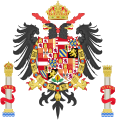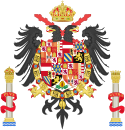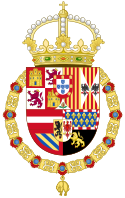Herb Hiszpanii
 | |
| Informacje | |
| Wprowadzono | 5 października 1981 |
|---|---|
| Dewiza | łac.: Plus Ultra (Wciąż dalej) |
W herbie Hiszpanii znajdują się godła królestw, które w czasach średniowiecznych zjednoczyły się w walce wyzwoleńczej przeciwko Maurom (tzw. Rekonkwista). Były to: Kastylia (zamek), León (lew), Aragonia (słupy), Nawarra (łańcuch). U dołu tarcz herbowych - owoc granatu, symbol Grenady, która była ostatnią twierdzą Maurów, zdobytą przez Hiszpanów w roku 1492. Napis Plus ultra (łac. wciąż dalej) to aluzja do odkrycia Nowego Świata przez Kolumba. Dwie kolumny obok tarcz herbowych to Słupy Heraklesa, znajdujące się po obu stronach Cieśniny Gibraltarskiej. Opanowanie tych terenów miało znaczenie strategiczne z punktu widzenia żeglugi morskiej. Na prawym słupie jest korona cesarska, a na lewym – królewska. Słupy symbolizują siłę Hiszpanii. Owalna tarcza w środku godła zawiera herb hiszpańskiej panującej dynastii z rodu Bourbon-Anjou (Burbonów-Andegawenów) oraz korony jako symbol monarchii jaką jest Hiszpania.
Dawny wygląd herbu
Obecny herb przyjęto w 1981. We wcześniejszych latach często się zmieniał, co było związane z burzliwą historią Hiszpanii. Na początku XX wieku monarchia hiszpańska używała herbu dwudzielnego - z prawej heraldycznej był kastylijski zamek, z lewej lew. Całość wieńczyła korona.
Herb republikański był bardzo podobny do obecnego - różnił się koroną (corona muralis, a nie królewska), brakiem symboli dynastii oraz detalami.
Herb w okresie rządów generała Franco przybrał inną postać - tarczę herbową (bardziej rozbudowaną niż obecna) trzymał czarny orzeł.
Joanna I Kastylijska i Filip I
1516-1518
Józef Bonaparte (1808-1813)
Rząd Tymczasowy (1868-1870) Pierwsza Republika (1873-1874)
Amadeusz I (1870–1873)
Restauracja Monarchii (1874-1931)
Druga Republika (1931-1939)
1945-1975
1975-1977
Zobacz też
Linki zewnętrzne
Media użyte na tej stronie
Autor: Heralder, Licencja: CC BY-SA 3.0
Coat of arms of Spain, 1874-1931-Collar of the Golden Fleece Version
Autor: Heralder, Licencja: CC BY-SA 3.0
Coat of arms of Spain, 1874-1931-Pillars of Hercules
Autor: Heralder, Licencja: CC BY-SA 3.0
Coat of Arms of the Catholic Monarchs, (1492-1504)
Autor: Heralder, Licencja: CC BY-SA 3.0
Coat of arms of Charles I of Spain, common version (1516-1518)
Autor: Heralder, Licencja: CC BY-SA 3.0
Coat of Arms of Spain during the Provisional Government, 1868 - 1870 and the First Spanish Republic, 1873-1874
Autor: Heralder, Licencja: CC BY-SA 4.0
Coat of Arms of Spain under Franco's Regime (1939-1945) Used by the National faction At Civil Spanish War since 1938
Description: Quarterly, 1. and 4. grand quarters counterquartered, first and fourth Gules a castle triple-turreted each turret with three embattlements Or masoned Sable gate and windows Azure, second and third Argent a lion Gules crowned langued and armed Or, 2. and 3. per pale Or four pallets Gules and Gules on a chain in cross, saltire and orle Or an emerald. In base Argent a pomegranate Proper seeded Gules slipped with two leaves Vert. A coronet with eight flowers of which five visible. The whole on the eagle of St John displayed with wings inverted nimbed Or beaked and membered Gules armed Or, to its right and left a yoke and a bundle of arrows both with strings all Gules. The cri-de-guerre "Una Grande Libre" (one great free [nation]). The whole accompanied by two columns Argent on waves Azure crowned Or, the right and left column with scrolls reading "Plus" and "Ultra".
Autor: Heralder, Licencja: CC BY-SA 3.0
Coat of arms of Spain, Transition to democracy (1945-1977)
Autor: Heralder, Licencja: CC BY-SA 3.0
Greater Coat of Arms of Coat of arms of Charles I of Spain (Charles V as Holy Roman Emperor), (1530-1556)
Autor: Heralder, Licencja: CC BY-SA 4.0
Royal Greater Coat of Arms of Spain, 1761-1868 / 1874-1931 - Common Version with the Collar of the Order of the Golden Fleece (House of Bourbon)
Autor: Heralder, Licencja: CC BY-SA 3.0
Coat of arms of Charles I of Spain with the Flanders and Tyrol Escutcheon , common version (1518-1520)
Autor: Heralder, Licencja: CC BY-SA 3.0
Coat of arms of en:Ferdinand II of Aragon, 1504-1513
Autor: Heralder, Licencja: CC BY-SA 3.0
Coat of arms of Spain (1945–1977)
Autor: Heralder, Licencja: CC BY-SA 3.0
Coat of Arms of King Philip II of Spain also English King Consort-Variant used as Spanish Monarch, 1556-1558
Autor: Heralder, Licencja: CC BY-SA 3.0
Coat of arms of Philip I of Castile (As Monarch of Castile)
Autor: Heralder, Licencja: CC BY-SA 3.0
Coat of arms of en:Ferdinand II of Aragon, 1513-1516
Autor: Heralder, Licencja: CC BY-SA 3.0
Coat of Arms of Queen Joanna of Castile, called "the Mad"
Autor: Heralder, Licencja: CC BY-SA 3.0
Coat of Arms of King of Spain, 1580-1668 (Philip II, Philip III, Philip IV and Charles II)
Autor: Heralder, Licencja: CC BY-SA 3.0
Middle Coat of Arms of Joseph Napoleón Bonaparte as Spanish Monarch
Autor: Heralder, Licencja: CC BY-SA 3.0
Coat of arms of Charles I of Spain, common version (1520-1530)
Autor: Heralder, Licencja: CC BY-SA 3.0
Royal Greater Coat of Arms of Spain, 1700-1761-Common Version with the Collar of the Order of the Golden Fleece and the Badge of the Order of the Holy Spirit
Autor: Heralder, Licencja: CC BY-SA 3.0
Coat of arms of Spain, 1936-1939 (Second Spanish Republic)
Autor: Heralder, Licencja: CC BY-SA 3.0
Coat of Arms of the Catholic Monarchs, 1474-1492)
Autor: Heralder, Licencja: CC BY-SA 3.0
Coat Arms of King Philip II of Spain, 1558-1580
Autor: Heralder, Licencja: CC BY-SA 4.0
Coat of Arms of Charles II of Spain, 1668-1700 (Common version)
- This Coat of arms was used by Archduke Charles of Austria as Royal Pretender
Autor: Heralder, Licencja: CC BY-SA 3.0
Coat of arms of Spain, 1871-1873-Pillars of Hercules variant
Autor: Heralder, Licencja: CC BY-SA 4.0
Coat of arms of Spain, 1874-1931-Variant with the Order of the Golden Fleece and Mantle
- Also used as alternative lesser arms of the King of Spain with the national arms (1874-1931) one lesser royal arms (1930-1931)




















































